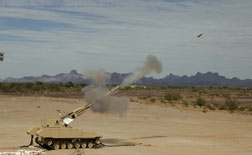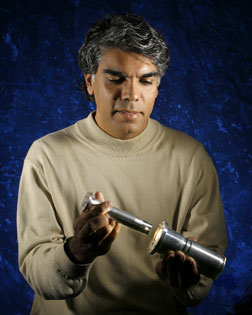NEWS RELEASES
FOR IMMEDIATE RELEASE
June 21, 2007
Sandia supports development of U.S. Army’s new lightweight, high-caliber, self-propelled cannon system
Lab’s modeling, systems capabilities contribute to Army’s Future Combat Systems modernization program
 The NLOS Cannon, developed by BAE Systems, is fully automated and can fire at a sustained rate of six rounds per minute. (Photo courtesy of BAE Systems)
The NLOS Cannon, developed by BAE Systems, is fully automated and can fire at a sustained rate of six rounds per minute. (Photo courtesy of BAE Systems)Download 300dpi JPEG image, “nlos-2006-oct23.jpg,” 412K (Media are welcome to download/publish this image with related news stories.)
LIVERMORE, Calif. — Researchers at Sandia National Laboratories in California have emerged as key players in a state-of-the-art program for the U.S. Army that focuses on the design and manufacturing of a lightweight, high-caliber, self-propelled cannon system.
The weapon system, known as the Non-Line-of-Sight Cannon (NLOS Cannon) is fully automated and can fire at a sustained rate of six rounds per minute. The vehicle, once completed, must be light and agile enough to fit three vehicles comfortably onto a C-17 cargo aircraft.
According to Sandia researcher Nipun Bhutani, who serves as project manager for the lab’s NLOS Cannon work, Sandia’s primary contribution to date has been a critical adjustment to a laser ignition system that serves as the heart of the NLOS Cannon vehicle. The cannon is part of Future Combat Systems (FCS), the Army’s premier modernization program.
This system is being developed by BAE Systems, as part of The Boeing Company/SAIC led FCS Program.
Sandia is a National Nuclear Security Administration laboratory.
Laser ignition unit: key to better precision, overall performance
The laser ignition system was developed by the Armament Research, Development and Engineering Center (ARDEC), in collaboration with Kigre, Inc. The unit is mounted on the back of the cannon’s gun barrel, where a laser beam is fired through an opening mechanism (the breech) to ignite the charge and launch an artillery shell. However, says Bhutani, the recoil force and shock of the projectile (bullet) discharge had caused an increase in observed failures during early prototype testing.
“The laser ignition system offers much better precision, rapid fire, and automation than the mechanical method, and it’s safer,” says Bhutani. “But it’s obviously not going to be an effective long-term solution if reliability cannot be maintained.”
Instead of abandoning the laser ignition concept in favor of traditional, mechanical ignition, the Army called in experts at Sandia, who deal with shock issues surrounding a wide range of components.
 Sandia’s Nipun Bhutani examines the NLOS Cannon’s laser ignition unit. Sandia researchers are developing an isolation system for the NLOS Cannon that acts much like a filter, resulting in much lower shock levels. (Photo by Randy Wong)
Sandia’s Nipun Bhutani examines the NLOS Cannon’s laser ignition unit. Sandia researchers are developing an isolation system for the NLOS Cannon that acts much like a filter, resulting in much lower shock levels. (Photo by Randy Wong)Download 300dpi JPEG image, “nipun-bhutani.jpg,” 412K (Media are welcome to download/publish this image with related news stories.)
Isolation system absorbs shock from gun discharge
To absorb the force from the discharge, Sandia and ARDEC jointly proposed a new isolation system between the laser and the breech. Vibration isolation systems are widely used to protect sensitive devices from vibrations or shock produced in their environment. Typical examples include isolating delicate laboratory experiments from floor-borne vibrations, or isolating a car body or airplane frame from engine vibrations.
Sandia, in collaboration with BAE Systems and ARDEC is developing an isolation system for the NLOS Cannon that acts much like a filter and results in much lower shock levels.
In addition to the isolation system, Sandia’s researchers then went several steps further and incorporated the lab’s modeling and experimental capabilities that are leading to hardening of the laser igniter.
Modeling leads to full systems approach
In an effort to develop the most optimal isolation system possible, Bhutani says the Sandia team needed to model the physics and inner workings of the laser system components. This involved modeling the gun loads and other physical dynamics inside the laser ignition system, particularly as it is fired.
“In keeping with Sandia tradition, we developed an entire systems approach to the problem,” says Bhutani, which included not only analysis and modeling of the isolation system but building a prototype and further researching the system’s performance and reliability. Sandia also did modeling work on the laser and breech. Sandia is also supporting BAE Systems’ test efforts.
One of Sandia’s long-term objectives with its NLOS Cannon work, says Bhutani, is to hone its customer relations reputation and strengthen alliances with BAE Systems; Armament Research, Development and Engineering Center (ARDEC); Benet Laboratories; and others. “We want to be known among our current and future customers as the ‘go-to’ lab,” says Bhutani.
About BAE Systems
BAE Systems is a global defence and aerospace company delivering a full range of products and services for air, land and naval forces, as well as advanced electronics, information technology solutions and customer support services. With 88,000 employees worldwide, BAE Systems’ sales exceeded 13.7 billion pounds sterling (US25.4 billion dollars) in 2006.
Sandia is a multiprogram laboratory operated by Sandia Corporation, a Lockheed Martin company, for the U.S. Department of Energy’s National Nuclear Security Administration. Sandia has major R&D responsibilities in national security, energy and environmental technologies, and economic competitiveness.
Sandia news media contact: Mike Janes, mejanes@sandia.gov, (925) 294-2447